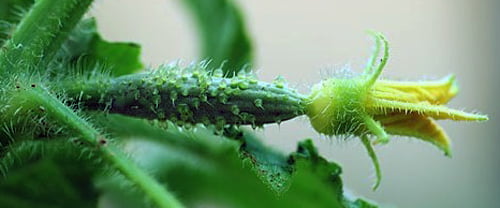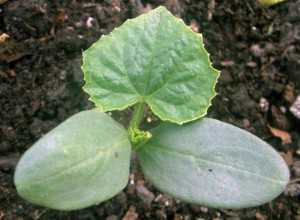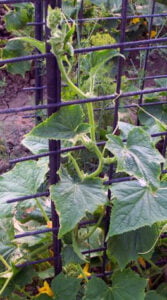Cucumber (Cucumis sativus) is a very popular vegetable, originates from India where it is cultivated for more than 3000 years. Many gardeners don’t grow this tasty veg, but if you can grow tomatoes, you can succeed with cucumbers too. They are delicious in summer salads and sandwiches and if you are a fan of juicing you must try lemon cucumber.
The right variety
As always growing starts with choosing the right variety for your growing conditions, and with cucumbers it is especially true.
Greenhouse cucumbers don’t grow well outside at all in most summers as they need lots of heat and humidity to grow successfully. Most F1 hybrid varieties are suitable for indoor growing only. These cucumbers produce all female flowers, where pollination is not necessary to produce the fruit, in fact if you plant non hybrid and hybrid cucumbers in the same greenhouse, the fruits can go bitter.
Outdoor or ridge cucumbers have the advantage of producing a good crop without any protection. These cucumbers are usually heirloom, well tested varieties producing male and female flowers and pollination does happen but will not make the fruits bitter. Marketmore, lemon cucumber and the Mohican are all grow well outdoors.
Sowing
The cucumber seeds need a temperature of 15 Celsius and above to germinate successfully. Sow the seeds in small individual pots, or two seeds in a pot and keep the stronger seedling. I recommend sowing the seeds no sooner than late April; at that time of the year they should germinate fine in an unheated greenhouse, or if you don’t have one, on your windowsill.
Keep the compost slightly moist, cucumber seedlings don’t like too much water and in the spring the greenhouse is still cool and the compost will not dry out for days. I did overwater many times my cucumber seedlings and they did not appreciate it at all; who would like to sit in cold water for days after all?
After germination, which takes 7-10 days, the seedlings grow quite fast even in the unheated greenhouse. When the cucumber seedlings have 2 pairs of true leaves they are ready to plant out. Be gentle when handling your cucumbers and if you plant the cucumber seeds into seed cells or very small pots, you have to replant the seedlings into individual pots. You can keep them in their pots until the fine roots appear on the bottom of the pots through the drainage holes. The young plants are prone to scorching so make sure you don’t place them too close to the glass and shade the greenhouse from late spring if necessary.
The seedlings will need some support from quite an early stage as cucumbers are climbers.
Plant out the seedlings in the greenhouse about 40 cm apart, supporting them with a cane or strong wire. Keep the main stem and few sideshoots as well. I found that cucumber plants can be vigorous in the greenhouse and the sideshoots can grow strong too and bear many fruits. I always leave 3 sideshoots in the greenhouse and make sure I feed the plants plenty of homemade liquid fertilizer. Pinch out the growing tips when they reached the top of the greenhouse or if you have the space you can train the main stem along the wall of the greenhouse. It is great fun and can squeeze out a late October crop from the plants.
Outdoors the cucumber plants can be left alone to grow as they wish on the ground or trained up on canes or on pea netting.
Powdery mildew can be a problem especially in the greenhouse. It is a fungal disease which appears as a fine white powdery fungi mycelium on the surface of the leaves, between the veins. It weakens the plants and later the leaves become dry and drop off. To prevent the plants make sure that there is enough air circulation by removing the lower yellowing leaves throughout the growing season, and by leaving lots of room between the plants. Two cucumber plants per growbag is recommended.
Cucumber mosaic virus spreads by aphids. If it attacks the leaves start yellowing in a mosaic pattern and if the disease gets serious the whole plant can get deformed not only the leaves and fruits.
Whitefly can be a problem also in the greenhouse. Make your own useful garlic spray, which strengthens the tissue of the plants and repels the insects, I use it regularly to prevent my crop from pests and diseases.




